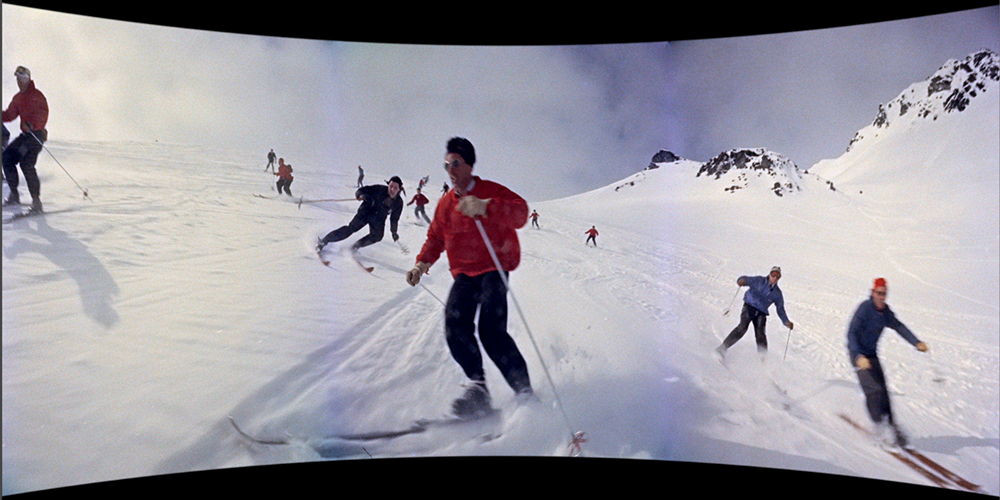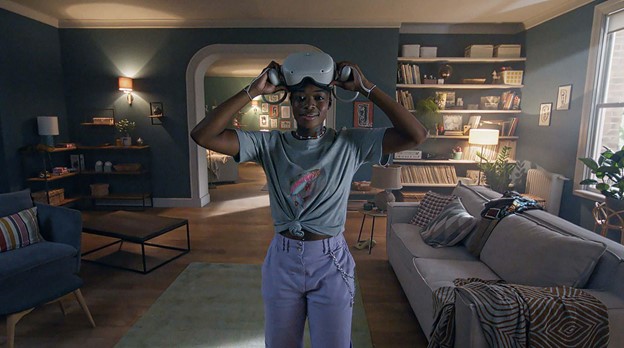What is Cinerama?
The filming process of Cinerama involves three cameras with 27mm lenses, conjoined to film multiple angles at the same time, creating a large depth of field. The captured footage is then displayed on a curved screen. The idea behind Cinerama seems to take over from where the film and theatre leave off, in that the camera setup is designed to make scenes feel as real as possible by taking in the same field of vision as the natural eye.
A few Cinerama pictures have been digitally restored; Cinerama Holiday was one of them. Cinerama Holiday was released in the 1950s when Hollywood and other global cinemas were desperate to take back audiences from the world of TV. For a brief period of time, this worked: Cinerama Holiday was popular, outselling all other films in 1955. Yet, Cinerama was an arduous process and only used sporadically throughout the 1950s–70s. Hence, it was somewhat short-lived.
Cinerama Holiday
Cinerama Holiday is a travelogue docu-fiction film that follows a Swiss couple exploring the US and an American pair discovering Europe. Along with the couples, the audience gets to visit a hodge-podge of beautiful landscapes and experience various traditions of the world. We visit the young American cities of the 50s, bobsled and ski in the Swiss Alps (which is so visceral you almost get motion sickness), visit local fairs and ride a Ferris wheel, fly inside a navy blue angel jet and more. It’s still thrilling to watch even 70 years on.

Back then, frequent travel or vacations abroad were few and far between, as shown near the beginning of the film when the narrator states the Swiss couple’s airplane was the first ever to land at St. Louis Airport from an overseas capital. The film is reminiscent of a highly sophisticated tourism advert, showcasing all the sights for the wide-eyed traveller in all of us.

Interestingly, Cinerama Holiday feels as if you are leading the trip yourself and lacks a director’s presence. The intentions behind Cinerama—and why I think it links to VR, the next phase of film—is again reinforced by the film’s content; the narrator describes the bold sights and new encounters of Las Vegas, saying it is a place where ‘people do things they cannot do at home’. The nuance of cinema, originally a place where you could watch things unavailable at home, is dying out. There needs to be something new, something people cannot do at home.
What does VR in cinema look like?

Higher stakes make emotional payoff much better and, thus, to revamp the cinema experience some element of VR seems like a natural progression.
VR, or virtual reality, is a computer-generated environment that can simulate the real world or an entire fabricated realm. Generally, users join by wearing specialist headsets and other additional equipment, such as hand consoles, for full immersion. It’s like going on a bobsled ride in Cinerama Holiday—but even more real.
VR headsets are not unheard of in the home, but the experience would not be as high quality as one taking place at a specialist cinema equipped for VR. Eventually, after a VR film’s cinema run, it could end up on streaming sites and everyone’s living room if needed. Unlike Netflix and other streaming platforms that are somewhat shunned from prestigious film festivals and seen as direct competition to cinema as we know it, VR is seemingly welcomed. There was even a VR exhibition at Sundance Film Festival in 2018.
At this event, Darren Aronofsky sold his VR series Spheres for a seven-figure sum. Spheres is a three-part series narrated by Jessica Chastain that explorers the various sounds of space. VR, it would seem, has confident backing from the industry. It just seems as though cinema chains themselves are too slow. For instance, Spheres was made accessible to those with the Oculus Rift (the most famous brand of VR headset) before becoming available on other VR platforms when it had the potential to be screened in theatres. Because traditional cinemas do not yet have the capability for VR spaces or special seating, they are losing out.
However, maybe this is how it is meant to go. Maybe the future of communal cinema experiences lies with headsets. For instance, Big Screen, an online platform with the tagline ‘watch movies and hang out with friends in virtual reality’, is already accommodating for the social benefits of traditional cinema.
In Big Screen, you can meet your friends in a virtual lobby, play games in the arcade while you wait for the film to start and so on. Of course, maybe this ‘headset’ future means we are at risk of turning into the unhealthy humans confined to VR loungers in Disney’s WALL-E. However, it is definitely exciting to posit how this will affect the average blockbuster or arthouse film and, even more so, the face of cinema.
VR to replace the real thing?
These things are inevitable. Cinema is bound to change drastically for survival. You may like stripped-back cinema, without all the toys and whistles, more. You may value the nostalgic and charming tone of Cinerama Holiday but ultimately find it outdated. However, if we go back to the first films (Louis Le Prince’s Roundhay Garden shoot and the famous train arriving at the station, which was rumoured to be so life-like it made some viewers faint), audiences were in awe of acts that now appear entirely too underwhelming for us to catch on camera.
If we look ahead to the face of cinema decades from now, most films might require headsets to view; they might even be fully interactive and immersive. And for us, in the present, this seems to ruin the cinematic experience, right? Future generations may not feel that way. Virtual realities and simulations in cinema could be for them what 3D, Cinerama, or a train arriving at the station is for us.